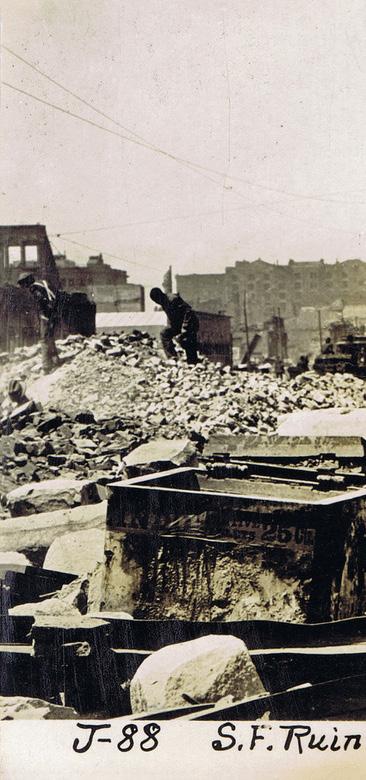
10 minute read
Unmasking the Phantom Photographer
By John Freeman
The catastrophic 1906 earthquake, fire, and subsequent rebuilding of San Francisco was extensively documented by many local photographers, amateur and professional alike. Some traveled from elsewhere to record the intense scenes. Locals had the advantage of being here from the first tremor and knowing the landscape and from where to seek the best perspective. The names of many of these photographers are well known, but one of the most prolific stayed behind the camera and cherished his anonymity. The time is well overdue to reveal not only his name, but tell the story of this remarkable contributor to a dynamic and dramatic moment in the history of San Francisco.
Advertisement
Those who research San Francisco’s history in the first decade of the 20th century will recognize many of this man’s photos, because they are found in numerous books that cover this time period. Yet it is extremely rare to note his name, and if it is noted, know who he was and the breadth of his photographic images. 240 of his negatives are found in the Walter Muhlmann Collection at the San Francisco Maritime Research Center, with 128 prints of those negatives at the California Historical Society. The History Center of the San Francisco Public Library has an album of real photo postcards without attribution except for the letter “J” and a number sequenced from 1 to 331. Some numbers are missing, and many images are not from the Muhlmann original negative cache. The California State Library in Sacramento has four scrapbooks of his photos, annotated in his unusual script, but filed under the name of the antique dealer, not the photographer. Since so many photo examples appear in public archival collections, it hints that our mystery photographer’s life’s work was much more extensive than what has been found so far.
The Summer 1976 issue of the California Historical Quarterly includes an article entitled “The City That Was: A Glimpse Just Before April 18, 1906, and Another Just After,” by Roger Olmsted. In the text, Olmsted describes all the photos he used as from a “Brown Bag Phantom,” implying a person who worked another job but took photos on their lunch break. Olmsted also notes that the article is a photographic essay developed from the forthcoming history of San Francisco by T. H. Watkins and R. R. Olmsted titled Mirror of the Dream. Indeed, the same titling for the photographer was used in the book that same year. All the photos used in both publications came from the Muhlmann Collection, which identifies the photographer as Balfe D. Johnson. Indeed, Balfe Johnson is
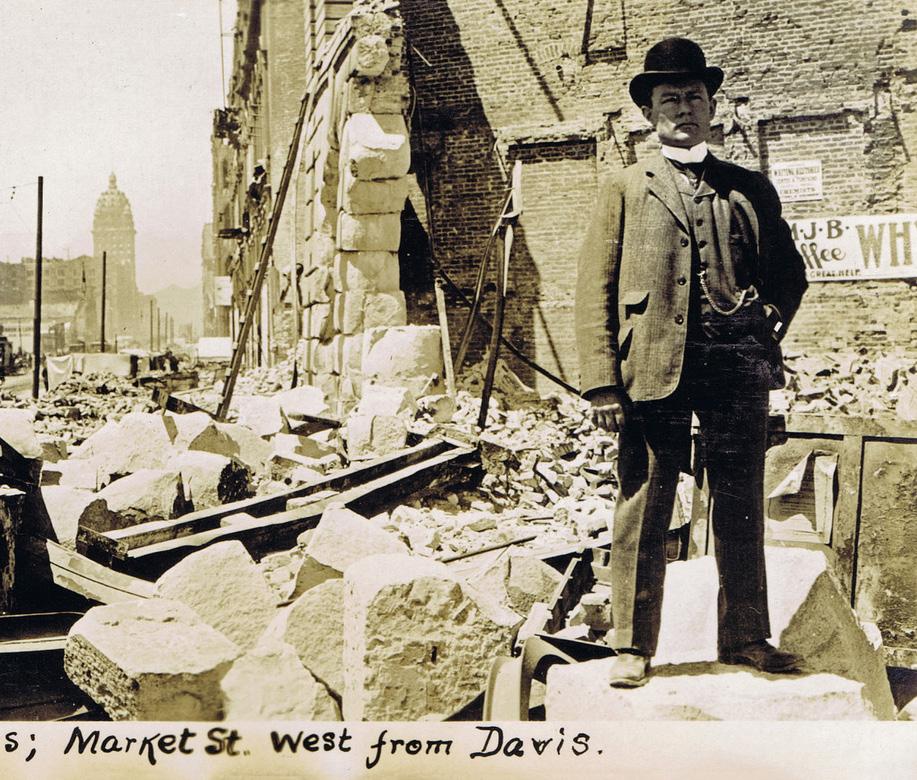
Balfe D. Johnson on Market Street, west from Davis, circa May 1906. (Courtesy of Glenn Koch)
the phantom, but why wasn’t he identified by name in these two publications?
I do not fault the authors, because at the time, historical research was tedious work that involved searching microfilms and visiting numerous institutions. Even San Francisco city directories only reveal that Johnson lived in the city and worked for Western Union Telegraph Company. Today, with the digitization of a wide variety of old newspapers and all manner of public records, tracing our ancestors or most historic persons has been revolutionized. Internet searches can reveal, in minutes, information that was previously very hard, if not impossible, to find.
Balfe Devore Johnson had a fabulous story to tell, yet he was very shy about telling it. He was born in Oregon City, Oregon in 1869, into a family of missionary preachers who were sent west in the 1840s to serve in the Oregon Territory. Johnson was accepted into the new Stanford University in 1891 and graduated as part of the Pioneer Class of 1895. He was a better scholar than his later acclaimed classmate, Herbert Hoover, majoring in history and using his self-taught telegraphy skills to supplement his family allowance by sending updates of campus news to the San Francisco Chronicle. When Stanford’s newspaper did a brief writeup on the 1895 graduates, Johnson declined the notoriety.
With his BA diploma from Stanford, Johnson returned to Oregon and was hired as a “Morse man” with Western Union. He was soon promoted to station manager for the coastal town of Astoria, where he was also compensated by the U.S. Weather Bureau for providing valuable maritime data from this important navigational site. In December 1895 he married Grace Mitchell, but the marriage ended in divorce likely
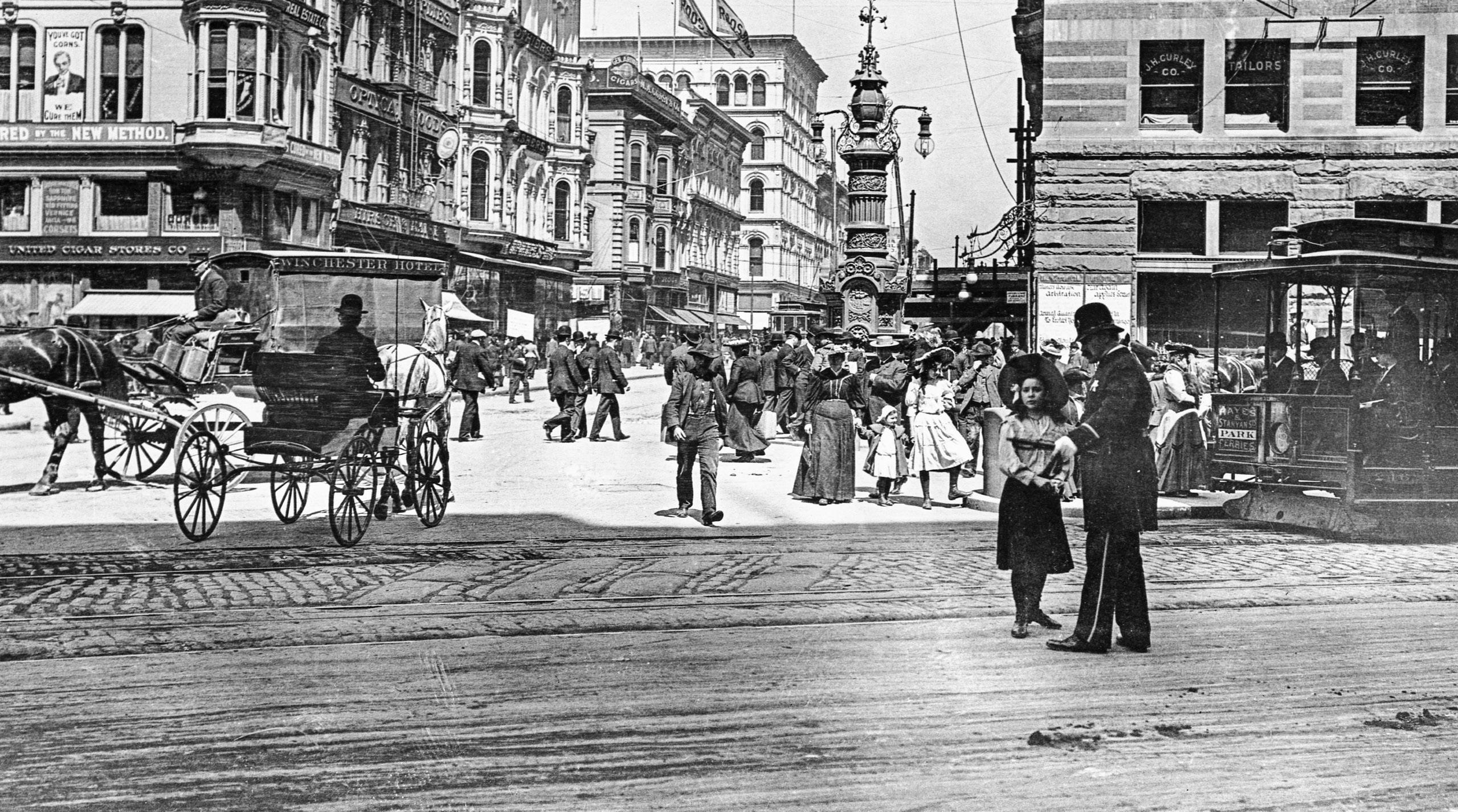
Market Street, looking north up Kearny, circa 1905. (Bill Kostura Collection; courtesy of a Private Collector / wnp26.1410)
by July 1903, when Johnson secured a transfer from Western Union to San Francisco. At some point in 1904 (based on the 1910 census), he remarried to Lillian Staats from Astoria; they lived together in San Francisco for the rest of their lives. Johnson got a plumb promotion from Western Union as a newspaper wire man, assigned as a night telegrapher at the San Francisco Chronicle. This job would be pivotal for Johnson because it placed him in a stimulating newspaper environment and allowed him the daylight hours to pursue his interest in photography. One of the most iconic of Johnson’s early photos, taken in 1905, is of a police officer chatting with a girl wearing a straw hat near Lotta’s Fountain, in front of the Chronicle building. Fortuitously, at the beginning of the week of April 16, 1906, Johnson purchased a new camera and stocked up on film for his spring photo escapades. He and Lillian were shaken out of their bed that Wednesday morning in their apartment at Jones and O’Farrell, and he began recording the unfolding tragedy. In an interview with the Chronicle, when he retired in 1940, Johnson said “I beat it right down to The Chronicle… And boy, were they glad to see me! They didn’t have any equipment, and their only photographer had gotten scared and run away to Oakland. I didn’t sleep for a couple of days, but I sure got pictures!”1
Johnson had an unusual relationship with the Chronicle. He was employed by Western Union to maintain their “wire,” yet provided earthquake and fire images for the newspaper while also freelancing some of his photos. It is a challenge to trace his work, not only because it was unsigned, but because negatives might have been sold or published widely without regard for copyright. Johnson’s photos have been colorized by postcard distributers, and show up in a variety of publications worldwide, with no attribution to the photographer. One particular group of photos were clearly a side contract for him. The Marsh-Girvin Stationary Company on Market Street, a half block from the Chronicle building, contracted with Johnson to use his negatives to produce a series of postcards. The Marsh-Girvin cards carried photos of the main tourist attractions, with numerous views skirting Lands End, attractions in Golden Gate Park, and the most compre-
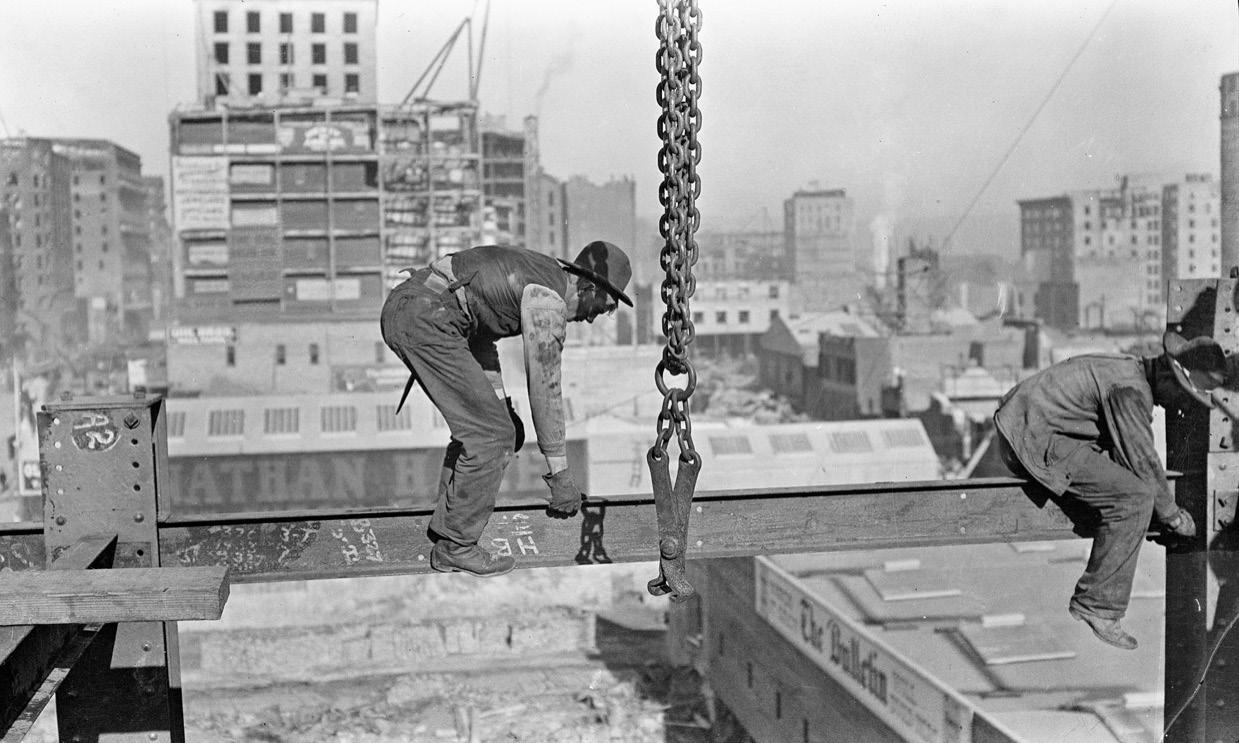
Ironworkers placing steel beams in place, Humboldt Bank Building, Market Street, fall 1906. (Courtesy of San Francisco Maritime National Historical Park)
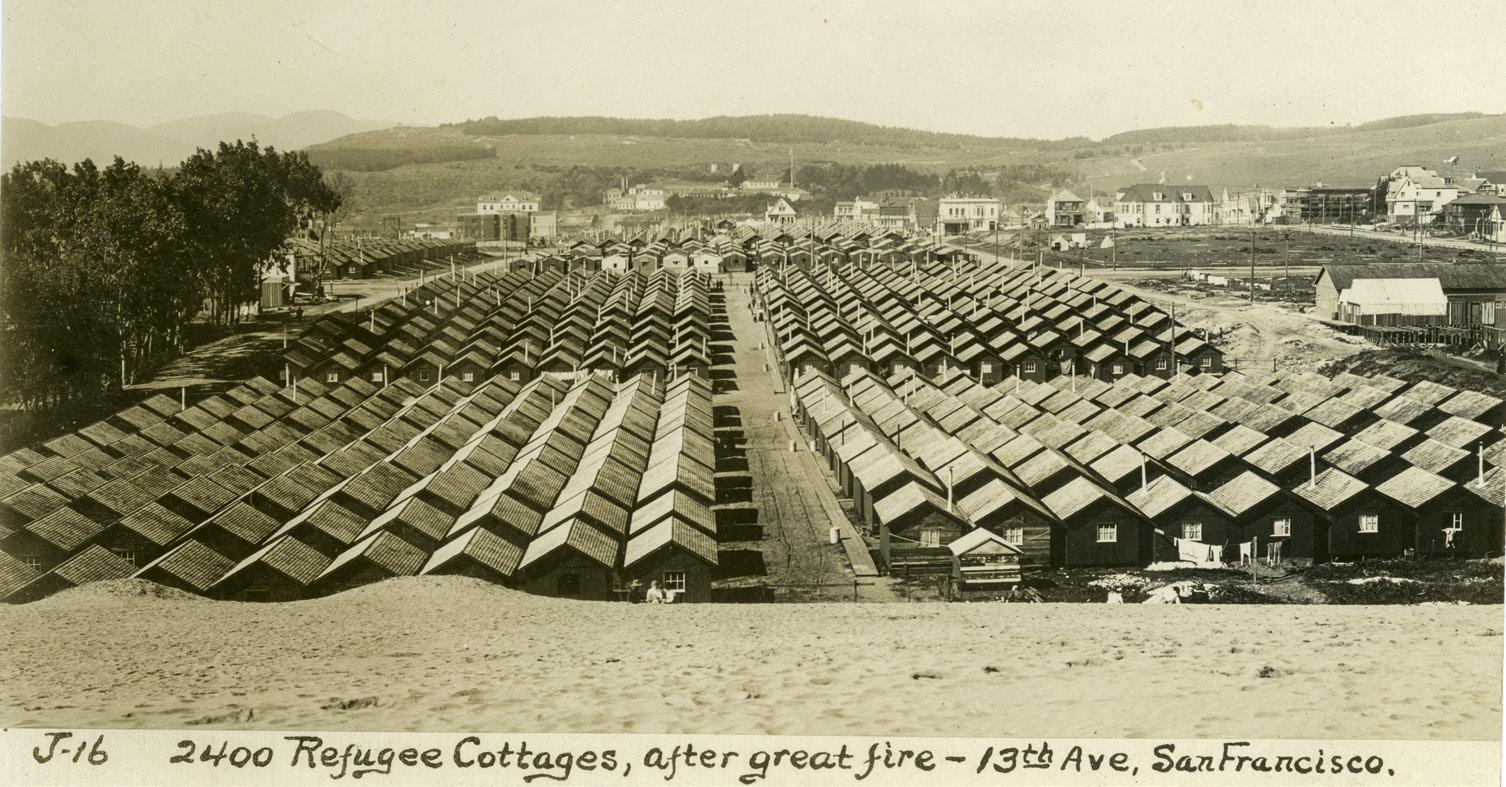
View north from about Balboa and Funston of Camp Richmond, 1906 earthquake and fire refugee camp. (Courtesy of a Private Collector / wnp27.7987)
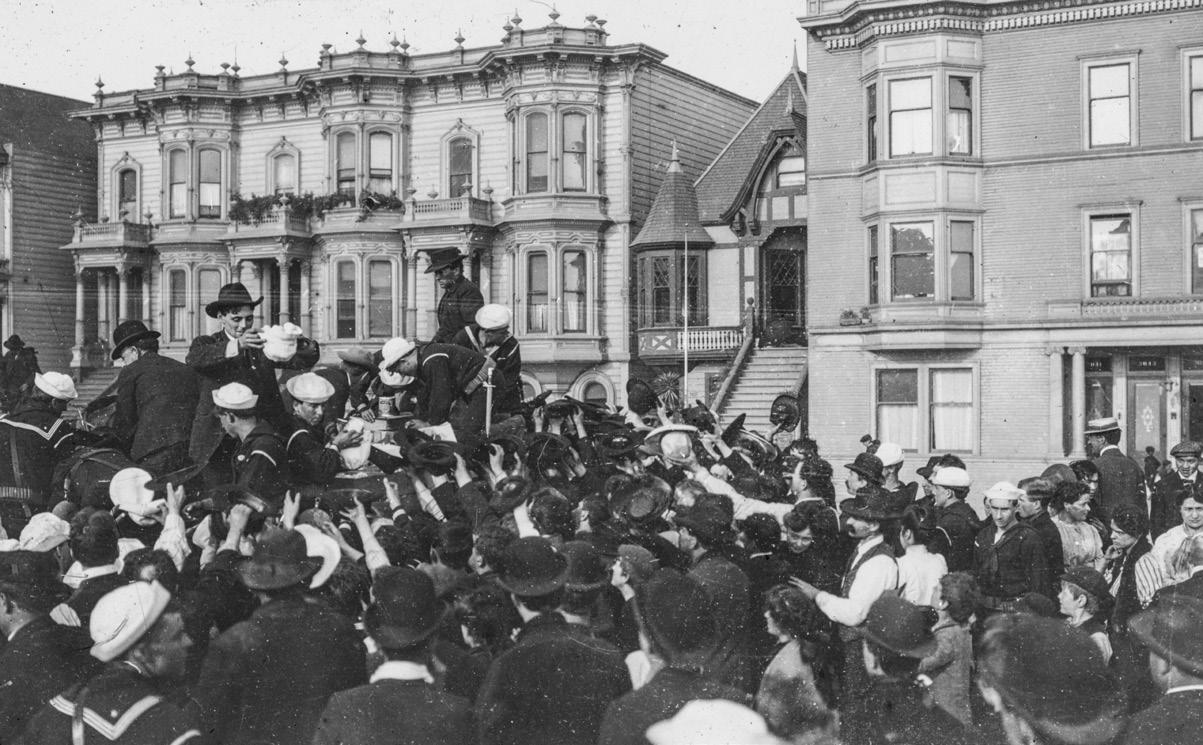
Eggs being distributed to a crowd by U.S. Navy sailors on the 3000 block of Van Ness Avenue near Bay Street, 1906. (Zelinsky Collection; courtesy of Dan Zelinsky / wnp59.00076)
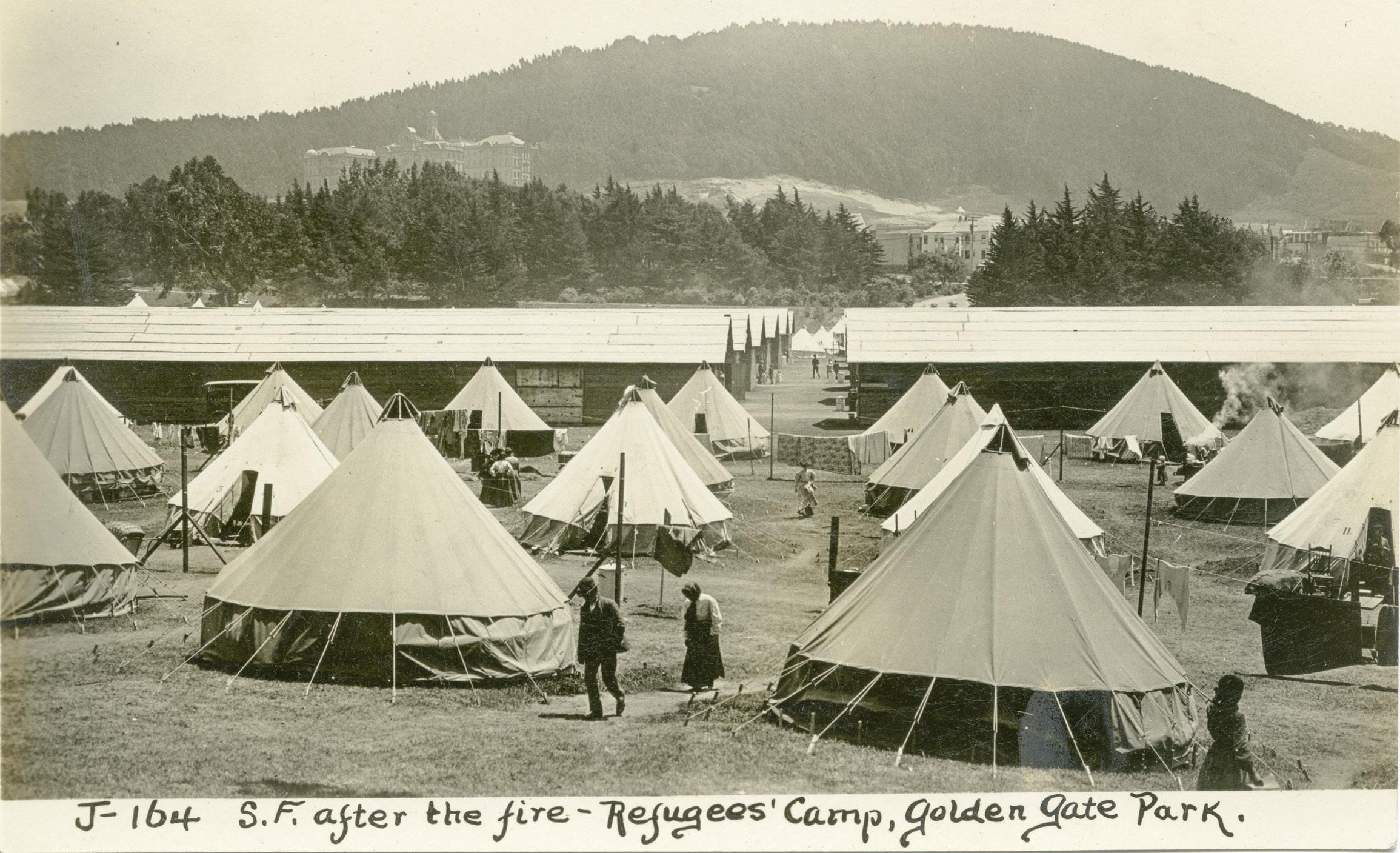
1906 earthquake and fire refugee camp no. 5 at Big Rec, Golden Gate Park. (Courtesy of a Private Collector / wnp27.7988)
hensive series of photos from the fire through rebuilding the city. What is most evocative of the quake-aftermath cards are the numerous views of the workers actively engaged in rebuilding jobs. Johnson also revealed his affection for his college days with two cards from the 1908 Cal-Stanford football game played in Berkeley, and a series of views of both campuses.
Balfe Johnson’s photographic work with the San Francisco Chronicle extended beyond the initial earthquake and fire images. By 1909, he became a lead photographer for their sports department. This was a time when newspapers were starting to devote more space to the sports of the day. Charles de Young, the son of Chronicle founder M. H. de Young, particularly admired Johnson’s ability to quickly send or transcribe a sports story on the ticker, but also his photographic skills. The department nicknamed him “Ban” to match the bold sports entrepreneur Byron Bancroft “Ban” Johnson, who was shaking up professional baseball by organizing a second league to rival the National League: the “American League.” The Chronicle’s “Ban” photographed horse racing and boxing matches. When assigned to capture baseball games, Ban experimented with a telephoto lens to capture action shots from afar, since photographers were forbidden on the field.
When the sensational “Fight of the Century” in 1910 between heavyweight title challenger Jack Johnson and over-aged champ James J. Jefferies was moved out of the Bay Area to Reno, Charles de Young was determined to “scoop” the nation with both written and photographic coverage. In the promotion prior to the Fourth of July match, the coverage team for the Chronicle was written up, featuring their lead photographer, B. D. Johnson. Charles de Young’s secret scheme was to procure a steam engine with a mail car, and remodel the car into a dark room. Johnson positioned himself among the army of photographers at ringside and snapped photos of the action in the over 100-degree sun. As the outcome became more and more obvious, with Jefferies outmatched even before a series of knockdowns in the 15th round, Johnson slipped away to get a head start in the special train. The race down the west slides of the Sierra was on, with Johnson doing the photo processing himself as they highballed it to the Bay Area to scoop the world on this historic, controversial match.
Johnson’s last photographic Chronicle assignment was on January 18, 1911, when he covered the famous flight of Eugene Ely from Tanforan infield to the specially-outfitted cruiser USS Pennsylvania, anchored in the bay across from San Mateo. The next morning, the Chronicle captioned the photo of the biplane’s touchdown, “Remarkable Photograph Taken by B. D. Johnson of the ‘Chronicle’ Art Staff.” As enigmatic as his appearance as a photographer, his exit was just as consistently baffling. This historic photo would be the last known by Balfe Johnson.
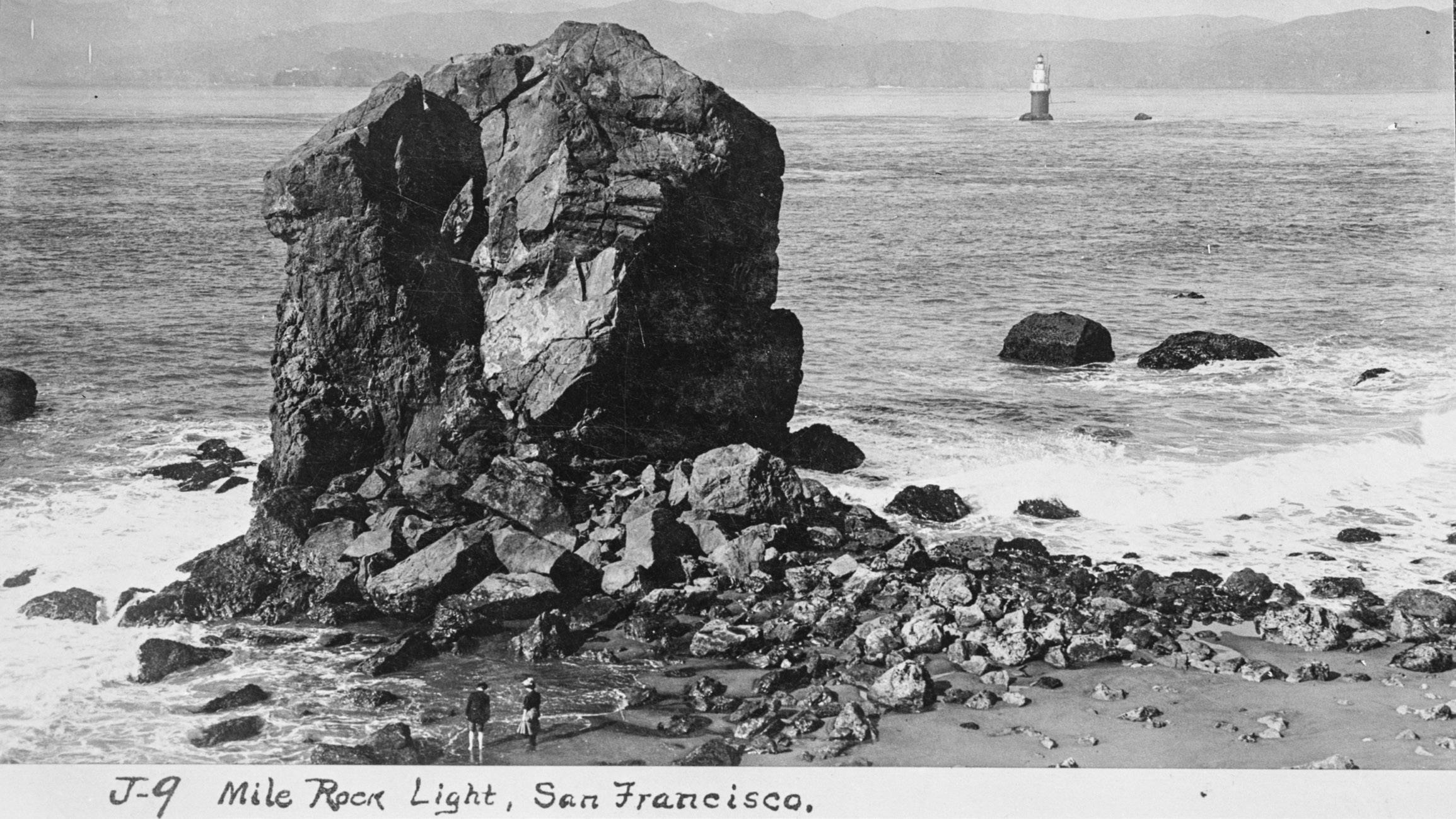
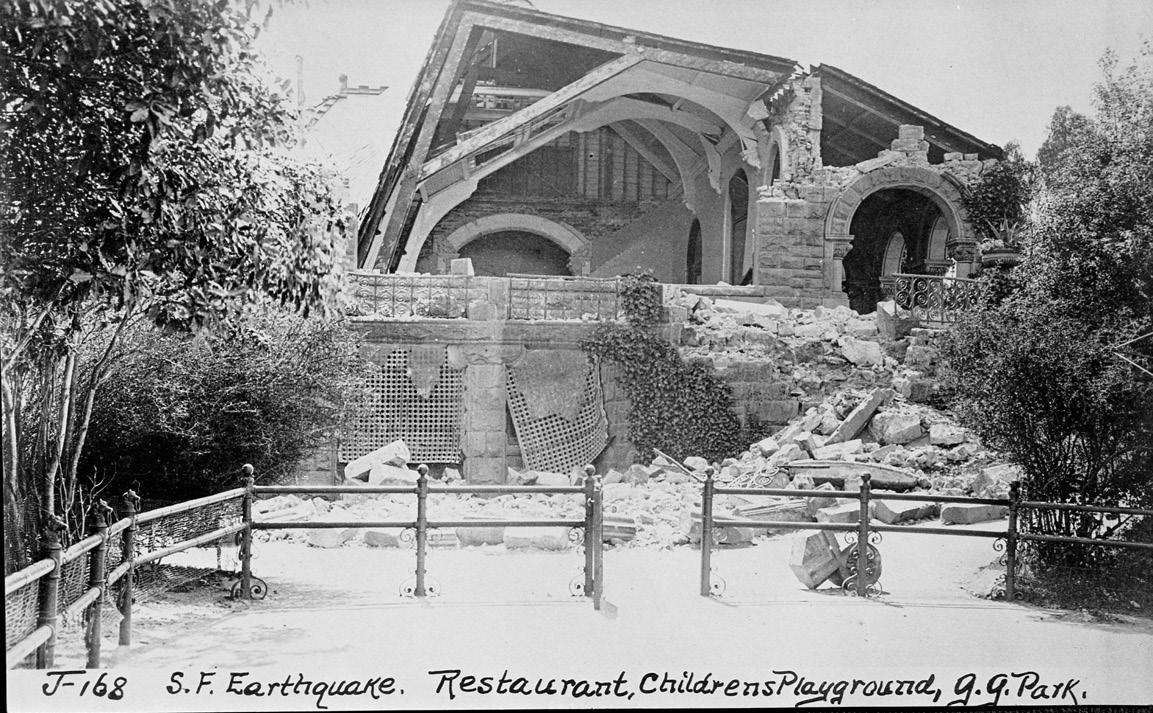
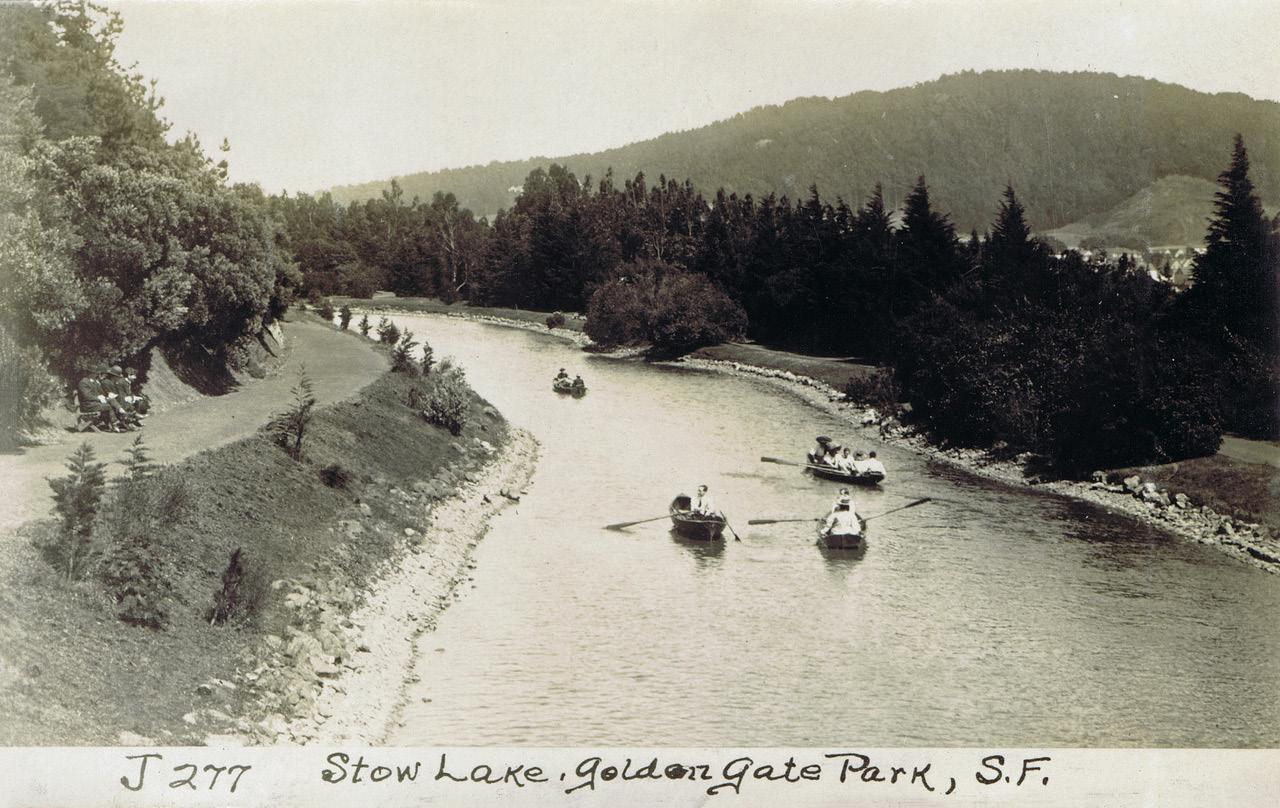
Clockwise: Helmet Rock and Mile Rocks Lighthouse, circa 1910. (Marilyn Blaisdell Collection; courtesy of a Private Collector / wnp37.01902); Stow Lake, Golden Gate Park. (Courtesy of Glenn Koch); Earthquake-damaged Sharon Building, Golden Gate Park, 1906. (Courtesy of a Private Collector / wnp26.1983)
His photographic side-work must have been profitable, because Johnson’s and his wife Lillian’s names appeared in the purchase and sale of at least eight lots in the Richmond District from 1911 to 1915. In 1915, they had a home built at 664 45th Avenue, which still stands. Today, there are taller buildings on the west side of the street which mar the view, but when built, the home had a sweeping vista of the ocean from the hill above Seal Rocks.
When Johnson announced he would retire from Western Union’s position at the San Francisco Chronicle, his friends at the sports desk wrote a glowing account of his life and accomplishments, published in the Sunday edition, April 28, 1940, entitled “Ban Johnson’s Ticker Days End Tuesday.” When Balfe Johnson died a little over eight months later, on January 13, 1941, the Chronicle noted his passing with a eulogy article. Both of these articles are lovely tributes to this accomplished man of mystery, but add no insight into his eight years of taking iconic Bay Area photos, or explain why he seems to have ceased producing any more photos after early 1911. Balfe and Lillian Johnson had no children, and lived over 26 years in the Richmond District, cherishing their ocean view. Lillian remained in the house on 45th Avenue until she died in 1945. Balfe Devore Johnson was not a phantom, but he did cherish his anonymity. It is long overdue to give credit to his accomplishments, and add his name to his fabulous legacy of iconic images captured over a brief, dynamic time in San Francisco’s history.
1. “Ban Johnson’s Ticker Days End Tuesday,” San Francisco Chronicle, April 28, 1940.







